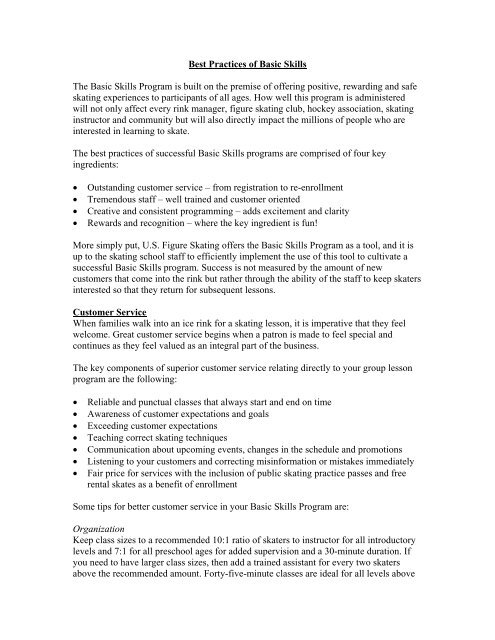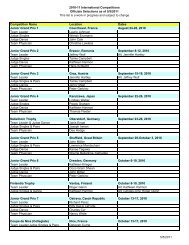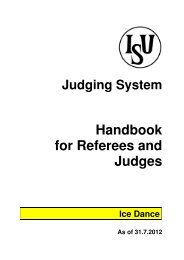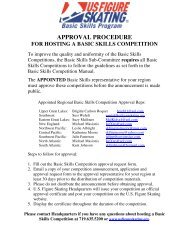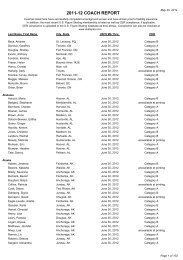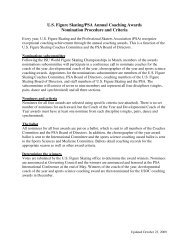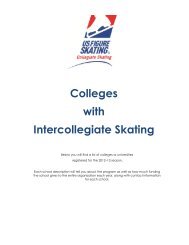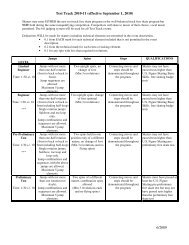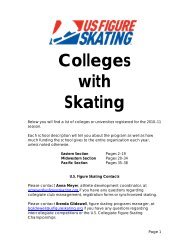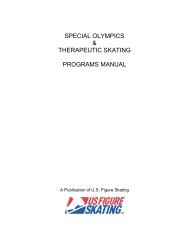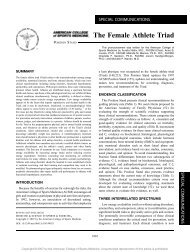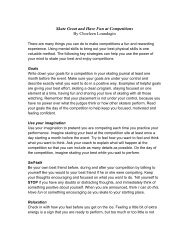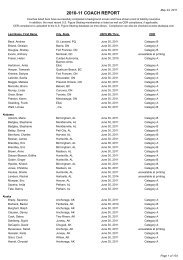Best Practices of Basic Skills The Basic Skills ... - US Figure Skating
Best Practices of Basic Skills The Basic Skills ... - US Figure Skating
Best Practices of Basic Skills The Basic Skills ... - US Figure Skating
You also want an ePaper? Increase the reach of your titles
YUMPU automatically turns print PDFs into web optimized ePapers that Google loves.
<strong>Best</strong> <strong>Practices</strong> <strong>of</strong> <strong>Basic</strong> <strong>Skills</strong><br />
<strong>The</strong> <strong>Basic</strong> <strong>Skills</strong> Program is built on the premise <strong>of</strong> <strong>of</strong>fering positive, rewarding and safe<br />
skating experiences to participants <strong>of</strong> all ages. How well this program is administered<br />
will not only affect every rink manager, figure skating club, hockey association, skating<br />
instructor and community but will also directly impact the millions <strong>of</strong> people who are<br />
interested in learning to skate.<br />
<strong>The</strong> best practices <strong>of</strong> successful <strong>Basic</strong> <strong>Skills</strong> programs are comprised <strong>of</strong> four key<br />
ingredients:<br />
<br />
<br />
<br />
<br />
Outstanding customer service – from registration to re-enrollment<br />
Tremendous staff – well trained and customer oriented<br />
Creative and consistent programming – adds excitement and clarity<br />
Rewards and recognition – where the key ingredient is fun!<br />
More simply put, U.S. <strong>Figure</strong> <strong>Skating</strong> <strong>of</strong>fers the <strong>Basic</strong> <strong>Skills</strong> Program as a tool, and it is<br />
up to the skating school staff to efficiently implement the use <strong>of</strong> this tool to cultivate a<br />
successful <strong>Basic</strong> <strong>Skills</strong> program. Success is not measured by the amount <strong>of</strong> new<br />
customers that come into the rink but rather through the ability <strong>of</strong> the staff to keep skaters<br />
interested so that they return for subsequent lessons.<br />
Customer Service<br />
When families walk into an ice rink for a skating lesson, it is imperative that they feel<br />
welcome. Great customer service begins when a patron is made to feel special and<br />
continues as they feel valued as an integral part <strong>of</strong> the business.<br />
<strong>The</strong> key components <strong>of</strong> superior customer service relating directly to your group lesson<br />
program are the following:<br />
<br />
<br />
<br />
<br />
<br />
<br />
<br />
Reliable and punctual classes that always start and end on time<br />
Awareness <strong>of</strong> customer expectations and goals<br />
Exceeding customer expectations<br />
Teaching correct skating techniques<br />
Communication about upcoming events, changes in the schedule and promotions<br />
Listening to your customers and correcting misinformation or mistakes immediately<br />
Fair price for services with the inclusion <strong>of</strong> public skating practice passes and free<br />
rental skates as a benefit <strong>of</strong> enrollment<br />
Some tips for better customer service in your <strong>Basic</strong> <strong>Skills</strong> Program are:<br />
Organization<br />
Keep class sizes to a recommended 10:1 ratio <strong>of</strong> skaters to instructor for all introductory<br />
levels and 7:1 for all preschool ages for added supervision and a 30-minute duration. If<br />
you need to have larger class sizes, then add a trained assistant for every two skaters<br />
above the recommended amount. Forty-five-minute classes are ideal for all levels above
<strong>Basic</strong> 4 and specialty classes. <strong>Basic</strong> <strong>Skills</strong> sessions can safely hold up to 80-120 people<br />
on the ice surface if space is managed correctly.<br />
Allow five minutes in between lesson times for staff to pick up their class rink side and<br />
drop them <strong>of</strong>f again. This helps with congestion while allowing safe transportation <strong>of</strong> the<br />
skaters to their class zones. Have all staff members (instructors, assistants or volunteers)<br />
wear some type <strong>of</strong> identifiable jacket so customers know immediately who is on staff and<br />
where to turn if questions should arise.<br />
Communication<br />
Keeping participants updated is very difficult and is <strong>of</strong>ten an area where the greatest<br />
pitfalls tend to occur. This obstacle can be overcome through information being listed on<br />
brightly colored flyers, handouts and notices posted on bulletin boards, in lobby areas, on<br />
the website, at the skate rental counter, included in e-mail blasts or sent out via text<br />
messages. Staffing the registration/welcome table each week with a knowledgeable<br />
employee or volunteer to answer questions is also helpful in keeping the lines <strong>of</strong><br />
communication clear.<br />
Class registrations should be taken by phone, mail, Internet, in person or on a walk-in<br />
basis. Waiting lists are not recommended, but if one must be used, be sure to pro-rate the<br />
registration fee if the skater begins class after the session has started.<br />
In addition to class registration fees, charging a yearly program registration fee will help<br />
pay for annual membership dues to organizations, provide a little extra income for use in<br />
advertising or can be used to cover overhead expenses. Your brochure should include all<br />
the information applicable for the entire year so participants may plan for each session<br />
and any special events such as competitions, exhibitions and ice shows.<br />
Offer incentives/rewards to the skaters<br />
Every registered member receives a record book to track his or her progress with stickers<br />
after skill mastery. Have instructors sign the skaters’ books following completion <strong>of</strong> the<br />
level and post a success chart at the rink for everyone to observe the progress <strong>of</strong> the<br />
skaters in your program. Include a “Brag Board” for all the students who have passed<br />
either <strong>Basic</strong> 8 or Free Skate 6, or those that have advanced and graduated to your figure<br />
skating club or hockey program.<br />
Distribute report cards both midway and at the end <strong>of</strong> each session with comments about<br />
their performance, things they did really well and tips for improvement. Give stickers to<br />
the skaters for good effort, good behavior and a job well done. Give out the badges when<br />
they pass a level free <strong>of</strong> charge to the skaters. This is a nominal cost to your program but<br />
is invaluable to the participants (plus free advertising around town).<br />
Staffing Considerations<br />
A successful <strong>Basic</strong> <strong>Skills</strong> program requires a great deal <strong>of</strong> planning and organization.<br />
Hiring a qualified skating director is vital to the success <strong>of</strong> the program, as it is his or her<br />
responsibility to implement, oversee and coordinate the execution <strong>of</strong> activities included
within the program <strong>of</strong>ferings. Great skating directors not only possess an extensive<br />
skating background and a through understanding <strong>of</strong> the program but are also capable <strong>of</strong><br />
effectively designing, overseeing, promoting, marketing and overseeing all program<br />
operations. <strong>The</strong> director must also have strong interpersonal, administrative,<br />
organizational and customer service skills. He or she should be held accountable for the<br />
overall success <strong>of</strong> the program while striving toward building/maintaining strong<br />
relationships with all "next step" programs.<br />
<strong>The</strong>re are three main areas <strong>of</strong> responsibility that exist for skating directors:<br />
1.) Administrative duties<br />
2.) Membership<br />
3.) Public relations<br />
Thorough and complete descriptions <strong>of</strong> these crucial areas <strong>of</strong> responsibility can be found<br />
on the <strong>Basic</strong> <strong>Skills</strong> Directors page on www.usfigureskating.org (click "Programs," then<br />
"<strong>Basic</strong> <strong>Skills</strong>").<br />
Training your staff<br />
It is crucial that every staff member consider themselves part <strong>of</strong> the team working<br />
cohesively toward the retention <strong>of</strong> skaters and continued success <strong>of</strong> the program. Staff<br />
members are the ultimate keys for success (or failure) <strong>of</strong> a program, as they are the ones<br />
on the front line directly communicating with the customer base on a consistent basis. A<br />
well-trained staff member will know the rink policies, has a “safety first” mentality,<br />
possesses the technical knowledge <strong>of</strong> skills, is organized, dependable, punctual and<br />
pr<strong>of</strong>essional in appearance, and puts forth extra effort to promote the program.<br />
In hiring qualified staff, seek out those individuals with a strong skating background,<br />
prior work history and excellent customer service skills. At this level <strong>of</strong> skating, you can<br />
hire for attitude and train the employee on the teaching/testing standards you desire.<br />
Consistently evaluating the staff’s performance by examining their re-enrollment records<br />
and participant drop-<strong>of</strong>f totals, and by listening to what your customers say about them<br />
are all terrific measures <strong>of</strong> competency. Be proactive in discussing the positive and<br />
negative feedback you receive with the staff member directly and be sure to keep a<br />
written record <strong>of</strong> this discussion in his or her personnel file for future reference.<br />
U.S. <strong>Figure</strong> <strong>Skating</strong> <strong>of</strong>fers instructional manuals, skating director resources, lesson<br />
planning booklets, skills DVDs, skill cards and a "Learn to Teach" written test to assist<br />
with the training <strong>of</strong> new instructors. <strong>The</strong> ideal instructional staff is set up as a tiered<br />
structure with a pay scale based on experience and credentials consisting <strong>of</strong> senior staff,<br />
junior staff, assistants and volunteers. Make sure you also set up an incentive program<br />
with specific criteria for upward movement and reward instructors with high retention<br />
rates.<br />
Creative and consistent programming
<strong>The</strong> <strong>Basic</strong> <strong>Skills</strong> Program consists <strong>of</strong> 12 different badge curriculums to use throughout<br />
the year to enhance or vary your <strong>of</strong>ferings. <strong>The</strong>se are divided into fundamental and<br />
specialty curriculums depending on the age, interest and ability.<br />
Fundamental curriculums – Core classes to <strong>of</strong>fer at consistent and convenient times<br />
Snowplow Sam 1-3 (pre-school aged)<br />
<strong>Basic</strong> 1-8<br />
Hockey 1-4<br />
Adult 1-4<br />
Special Olympics and <strong>The</strong>rapeutic skating<br />
Specialty curriculums – Use to enhance and retain skaters in group lessons<br />
Free skate 1-6<br />
Synchronized team 1-4<br />
Ice dance 1-6<br />
Pairs 1-6<br />
Artistry in Motion 1-4<br />
Speed skating 1-6<br />
<strong>The</strong>atre on Ice 1-4<br />
It is also encouraged to expand programming to include Parent and Tot classes (Tall &<br />
Small), Kindergarten, home school, adult c<strong>of</strong>fee clubs and connect with local school<br />
districts for field trips to the rink or PE skating classes to help fill slow ice slots during<br />
the day. Developing packaged Bridge programs, <strong>of</strong>f-ice conditioning, special focus (Axel<br />
class), parent meetings and special events will help retain higher-level skaters. Add a<br />
"Learn to Compete" class before your <strong>Basic</strong> <strong>Skills</strong> competition so that new skaters can<br />
prepare in a group environment while reducing costs to families.<br />
Higher-level skaters inspire lower-level skaters; thus, exposing newer skaters to their<br />
more advanced peers can increase their desire to dream and continue skating. Try a<br />
buddy program or mentoring program, and invite higher-level skaters to perform an<br />
exhibition or skate their practice sessions right before or after group lessons so that newer<br />
skaters have the chance to watch them. Camaraderie and friendships go a long way<br />
toward the children’s enjoyment and continuance <strong>of</strong> skating.<br />
Skater Retention<br />
It has been proven that it costs far less to retain a current skater than to recruit a new one.<br />
<strong>Basic</strong> <strong>Skills</strong> programs should aim for at the minimum <strong>of</strong> a 60 percent retention rate (six<br />
out <strong>of</strong> 10 current skaters sign up for the next set <strong>of</strong> lessons), with an 80 percent retention<br />
rate being considered excellent. Monitoring your retention rates from session to session<br />
will provide useful insight as to why skaters may decide to stop skating. Often the<br />
reasons children may decide to stop skating include the challenge <strong>of</strong> a particular level,<br />
having to work with certain instructors, lack <strong>of</strong> enjoyment or simply a loss <strong>of</strong> motivation<br />
to continue. Offer “booster” lessons on public skating to assist skaters with a difficult<br />
skill, as those extra five minutes <strong>of</strong> personal attention may make all the difference in that<br />
person’s success and continued skating.
Your current customer base is one <strong>of</strong> your best resources for increasing enrollment and<br />
retention. Try <strong>of</strong>fering referral packages, family discounts or repeat-enrollment discounts<br />
to encourage loyalty and progression. Offering family discounts <strong>of</strong> $5 <strong>of</strong>f the second<br />
family member, $10 <strong>of</strong>f the third family member, second class half-<strong>of</strong>f pricing or reenrollment<br />
discounts for multiple sessions are other good ways to keep your current<br />
customer base strong.<br />
Giving your customers a simple evaluation survey at the conclusion <strong>of</strong> each session and<br />
following up on their responses not only makes them aware that you have read their<br />
surveys but also that you appreciate their time spent in giving feedback. Program<br />
evaluations should include questions such as "Would you (the parent) recommend this<br />
program to peers Why or why not" Knowing how your program is perceived helps<br />
boost your retention and gives you the ability to correct or modify any issues. Directly<br />
contacting parents <strong>of</strong> skaters who did not re-enroll to ask what contributed to their<br />
decision will benefit the program as well.<br />
Bottom line: <strong>The</strong> <strong>Basic</strong> <strong>Skills</strong> Program is a business that provides a service. How you<br />
treat your customers is vital toward your eventual success and can be easily achieved<br />
when one strives to deliver services in the most efficient and fun manner possible.<br />
If your rink is not currently running a U.S. <strong>Figure</strong> <strong>Skating</strong> <strong>Basic</strong> <strong>Skills</strong> program, please contact Susi Wehrli<br />
(swehrli@usfigureskating.org or 719.635.5200) for a free administration packet.


